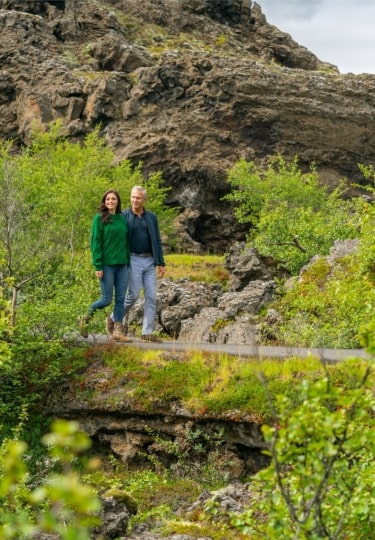The best things to do in Iceland, a cinematic island in the North Atlantic Ocean, range from hiking to cascading waterfalls to gazing at show-stopping scenery shaped by volcanoes and glaciers.
Lying a few miles south of the Arctic Circle, this small country, roughly the size of Kentucky, packs in some of the most dramatic landscapes in the world. Think ice caps, countless fjords, and extraordinary wildlife. Indeed, nature is a huge draw, with puffin colonies, migrating whales, and charismatic Arctic foxes to spot.
In the capital, Reykjavík, there’s an abundance of museums, shopping, and gastronomy, with some world-beating architecture to admire, too. Other cities, such as Akureyri and Ísafjörður in the north offer quaint museums, welcoming coffee shops, and fantastic whale watching. From hiking mountains carpeted in wildflowers to bathing in steaming geothermal pools, here are some of the best things to do in Iceland.
Marvel at Spectacular Waterfalls
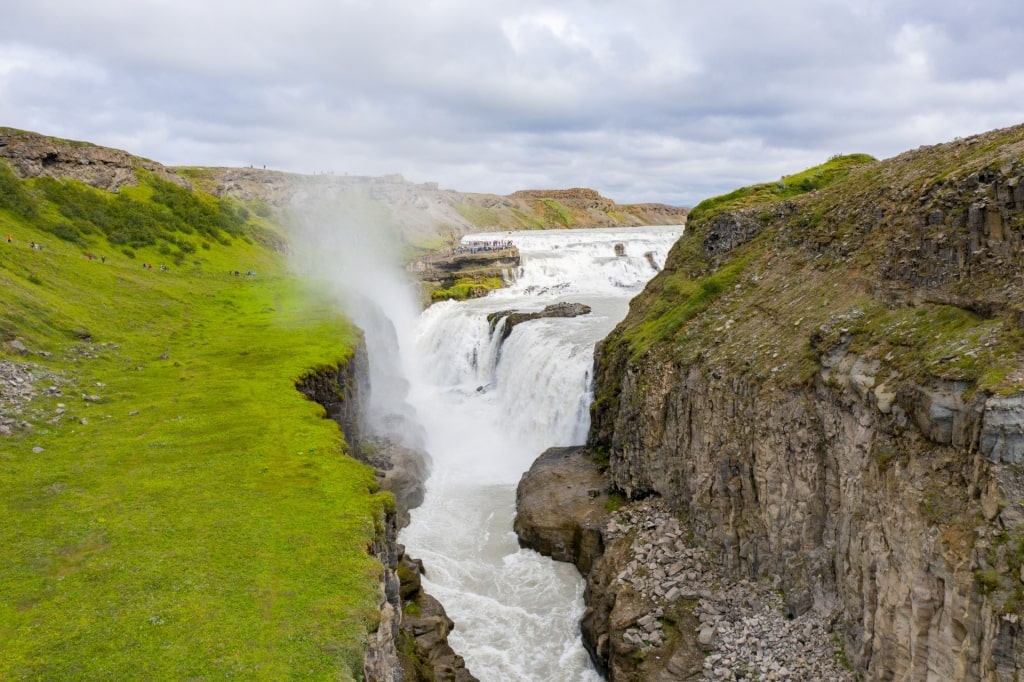
Gullfoss
There is no shortage of spectacular waterfalls in Iceland, including Gullfoss, a gasp-inducing waterfall that’s around 70 miles east of Reykjavík. Gullfoss, which translates as golden waterfall, lies in the Hvítá river canyon, with water flowing from the mighty Langjökull glacier, the second-largest glacier in Iceland.
The two-tiered waterfall drops 105 ft and lies on the country’s famous Golden Circle route, which also encompasses Haukadalur, a valley rich in geothermal activity, and Þingvellir National Park. It’s best to visit Gullfoss during summer, when it’s estimated around 459 cubic feet of foaming water pours down the canyon every second.
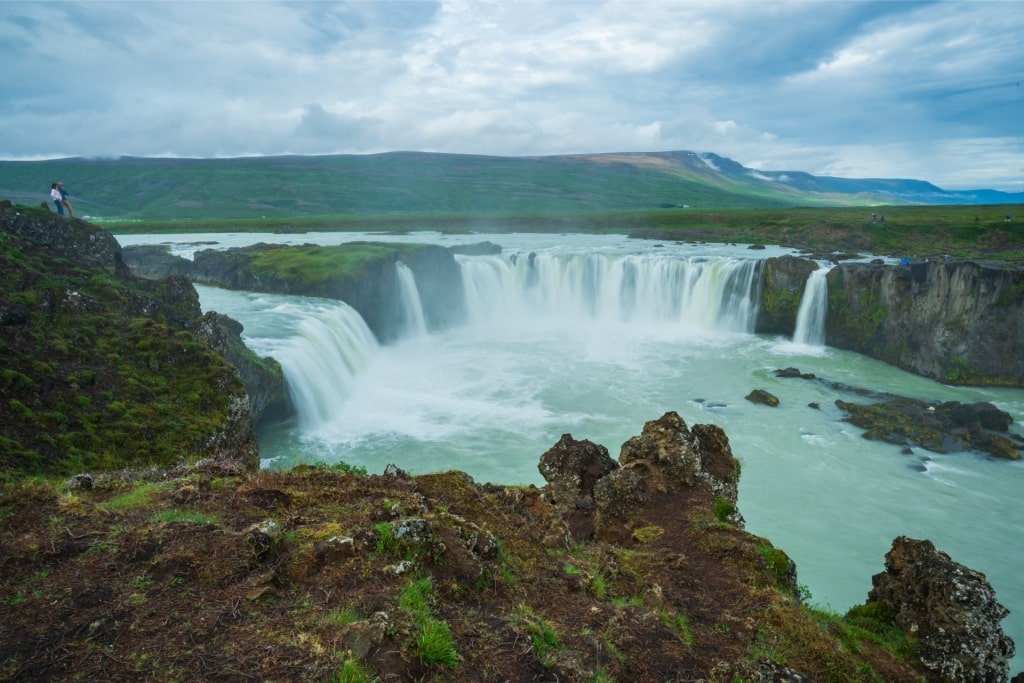
Goðafoss
In the north of Iceland, a 30-minute drive east of Akureyri, Goðafoss is one of the most beautiful places in Iceland. The waterfall also lies on a glacier river, Skjalfandafljot, and surges 39 feet over a curved, 100-foot-wide precipice.
Enjoy the cool spray as you marvel at the white water tumbling over the ledge and the backdrop of green mountains before learning about folklore tales associated with Goðafoss.
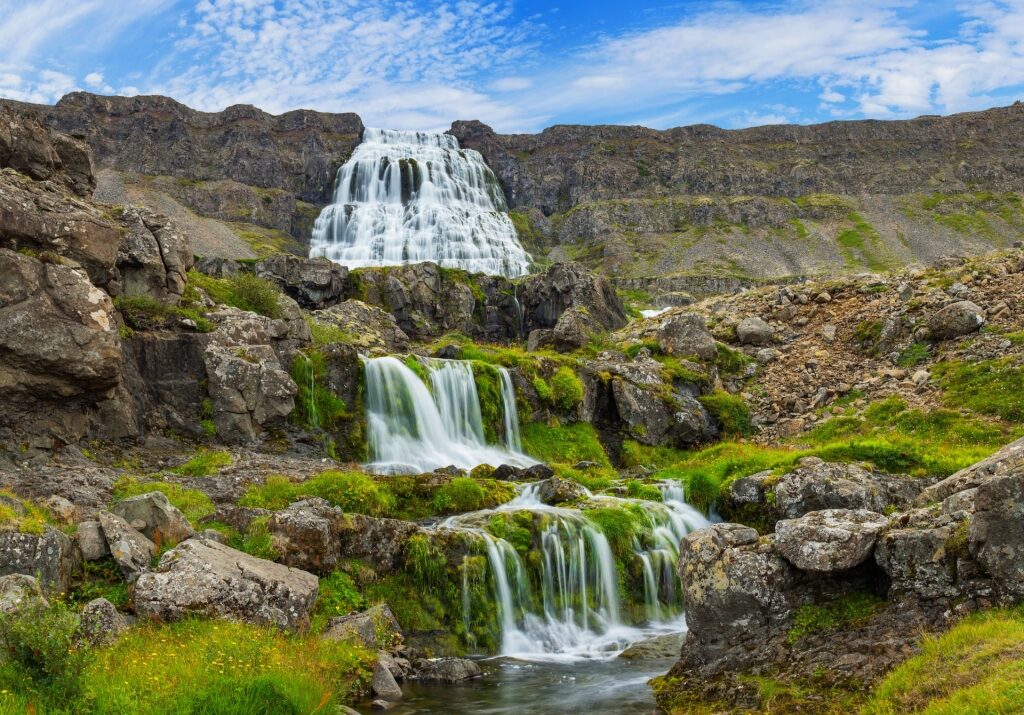
Dynjandi Waterfall
In the wild and remote Westfjords, in northwest Iceland, Dynjandi is another of the country’s captivating waterfalls. Here, travelers can marvel at the gushing water drop 325 feet to form a chalk-white veil.
Dynjandi is an awe-inspiring waterfall, 98 feet wide at the top, spreading to almost 200 feet at the bottom. On the path to reach Dynjandi, you’re treated to seven smaller falls, each flowing into the next before reaching the Arnarfjordur, the second-largest fjord of the Westfjords.
Bathe in Soothing Geothermal Water
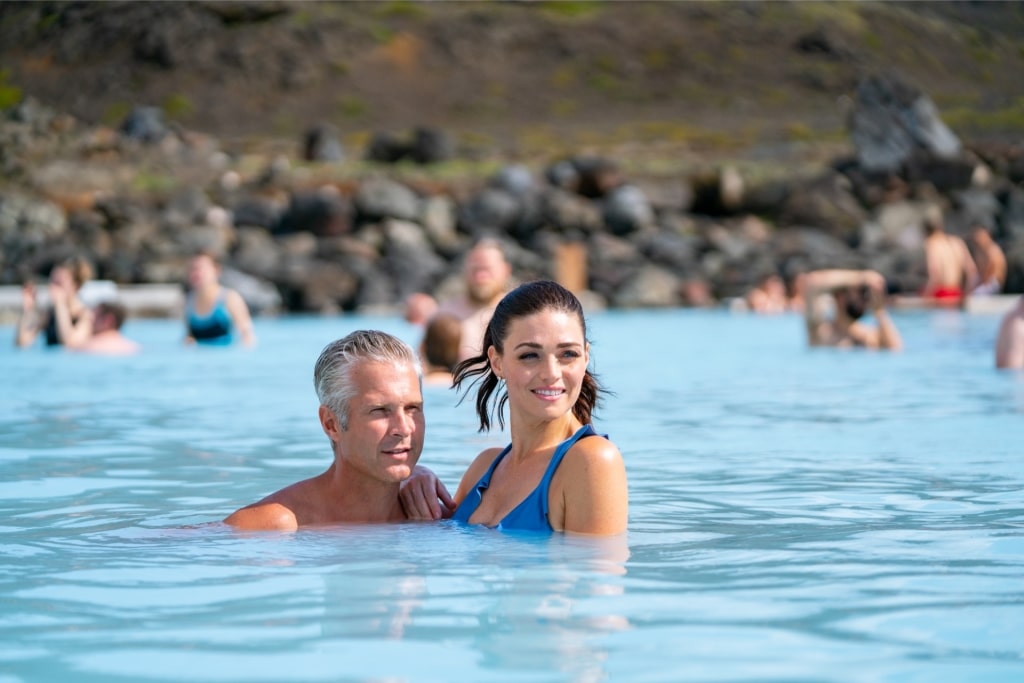
Mývatn Nature Baths
Iceland is well known for harnessing geothermal water to create soothing bathing spots nestled in nature. One such spot is Mývatn Nature Baths, 65 miles south of the Arctic Circle. This milky lagoon is heated through a deep fissure in the Earth’s surface.
There’s a swim-up bar with a selection of libations, a steam room that sees steam dramatically rise up through vents in the floor, and a café with indoor and outdoor seating.
One of the most famous geothermal bathing spots to experience Iceland’s nature is the Blue Lagoon, located on the fiery Reykjanes Peninsula. Lying among black rock formations, the Blue Lagoon is a 40-minute drive from Reykjavík and has been considered one of the best things to do in Iceland since opening in 1987.
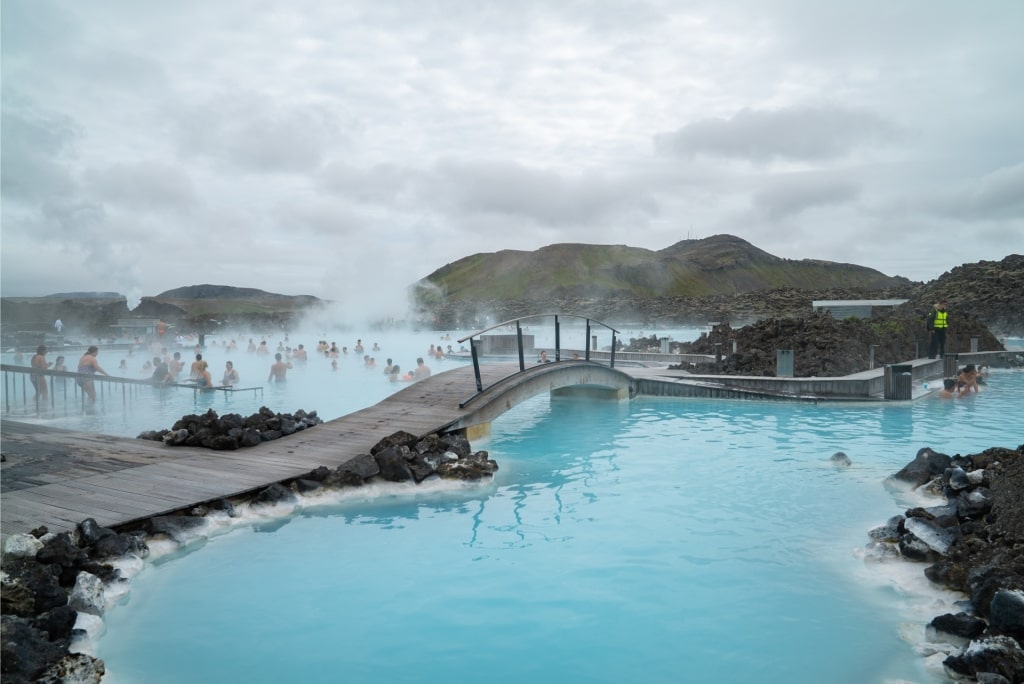
Blue Lagoon
Lather mud onto your skin and relax in the silica and sulfur-rich water, which is heated to a sumptuous 100°F (38°C). There’s also a spa, where therapists use the Blue Lagoon’s own healing and nourishing products, a café, a restaurant, and a gift shop.
Another tranquil spot, a 45-minute drive north of Reykjavík, is Hvammsvík Hot Springs. Here, eight natural tidal pools cling to the oceanfront, with temperatures ranging from 50°F (10°C) to 107°F (42°C). Subject to weather conditions, paddleboards can be hired and steam baths and outdoor showers are available year round. Due to the natural rocky surface at Hvammsvík, bathers are advised to wear aqua shoes.
Admire Magnificent Icelandic Horses
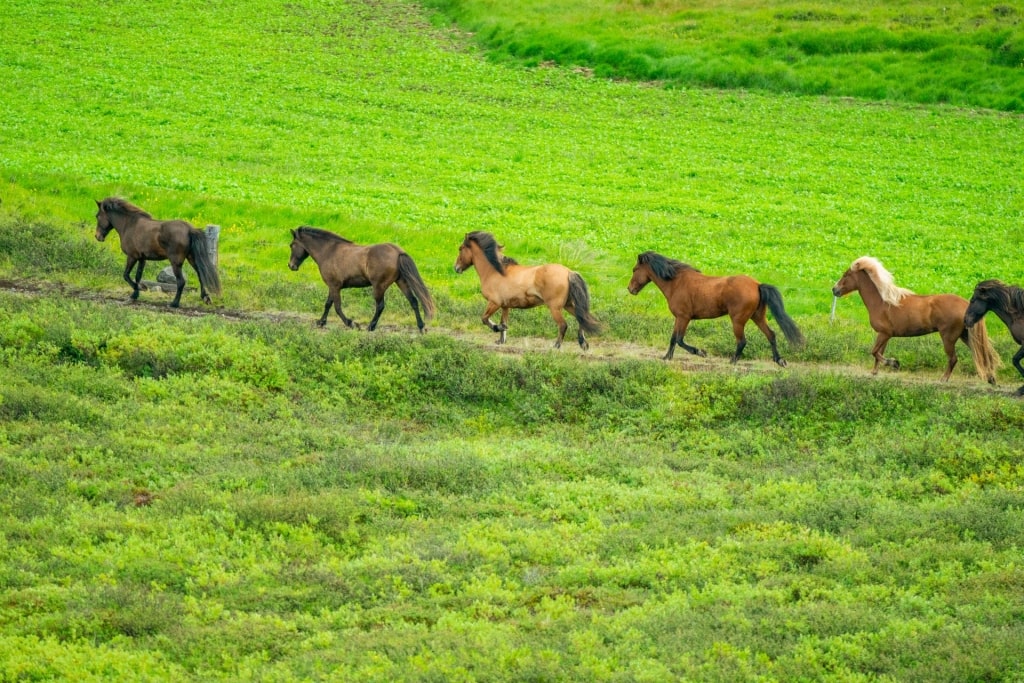
Icelandic horses
Just a few miles south of Akureyri, Brunir Horse Farm is a family-run farm that hosts enthralling horse shows throughout summertime.
Icelandic horses are as symbolic of Iceland as volcanoes and hot springs. They’re typically small, unique for their five gaits (walk, trot, gallop, tölt, and flying pace) and are traditionally used for herding sheep, showing, and racing.
At Brunir Horse Farm you can learn how Icelandic horses, the only breed of horse in Iceland, were bred from ponies as early as the 9th century. Visitors can meet farmers Einar and Hugrún and their twin daughters, Guðbjörg and Þórhildur, and meet some of these majestic creatures
After taking in a horse show, browse the farm’s art exhibition, featuring artwork by Einar and other Icelandic artists. There’a a café, too, where visitors can savor warming coffee, homemade bread, soup, cakes, and pastries.
Wander Siglufjörður Village
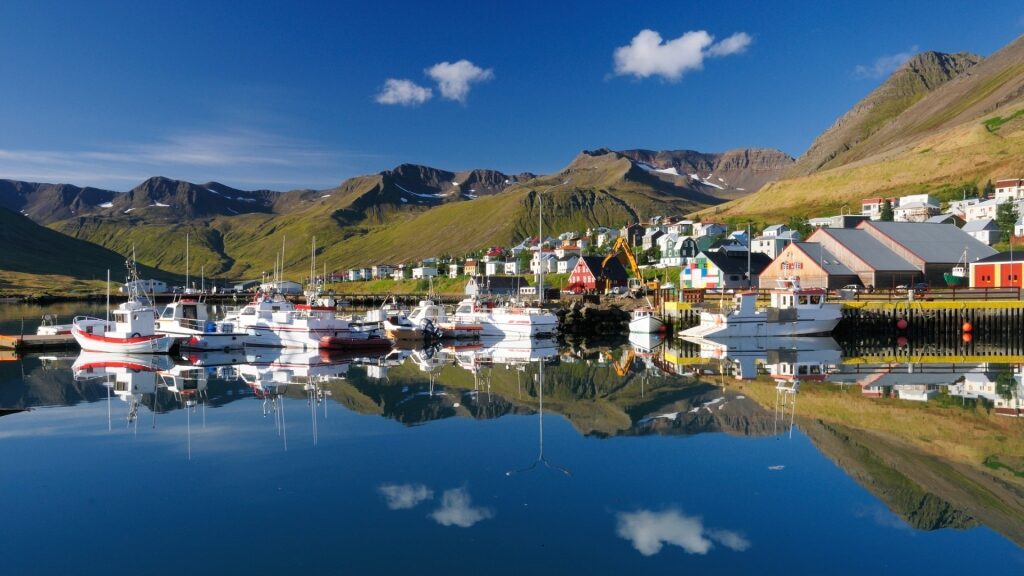
Siglufjörður Village
Iceland’s most northern village is the postcard-worthy Siglufjörður. Once the country’s herring fishing capital, Siglufjörður is surrounded by snow-capped mountains, lying on the Siglufjordur fjord on the remote Trollaskagi peninsula.
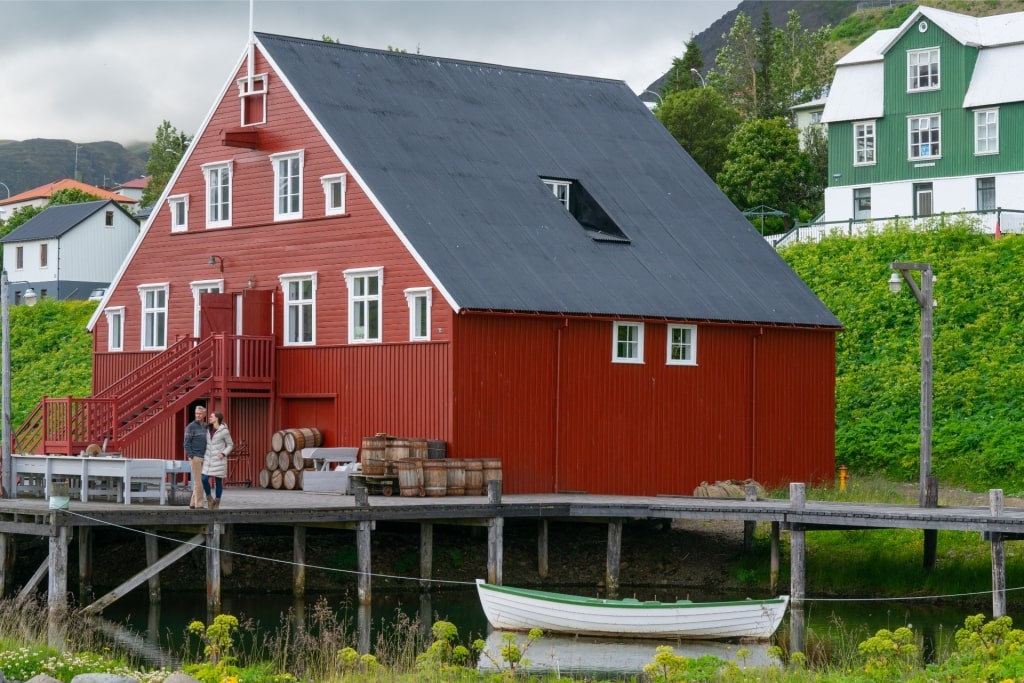
Herring Era Museum, Siglufjörður
Though small, there’s plenty here to captivate travelers, including the cleverly executed Herring Era Museum on Siglufjörður’s waterfront. As the name suggests, this three-building museum charts the region’s herring industry. The museum is housed in a former herring salting station and offers a window into the once thriving industry, which collapsed in 1969 due to a lack of herring stock.
Nearby, there’s a craft brewery, Segull 67, where thirsty travelers can take a tour before sampling the selection of excellent IPAs, lagers, and stouts. Siglufjörður also boasts a folklore center housed in a mustard-yellow building, an art gallery, and several cafés and restaurants.
Go Whitewater Rafting on the Hvita River
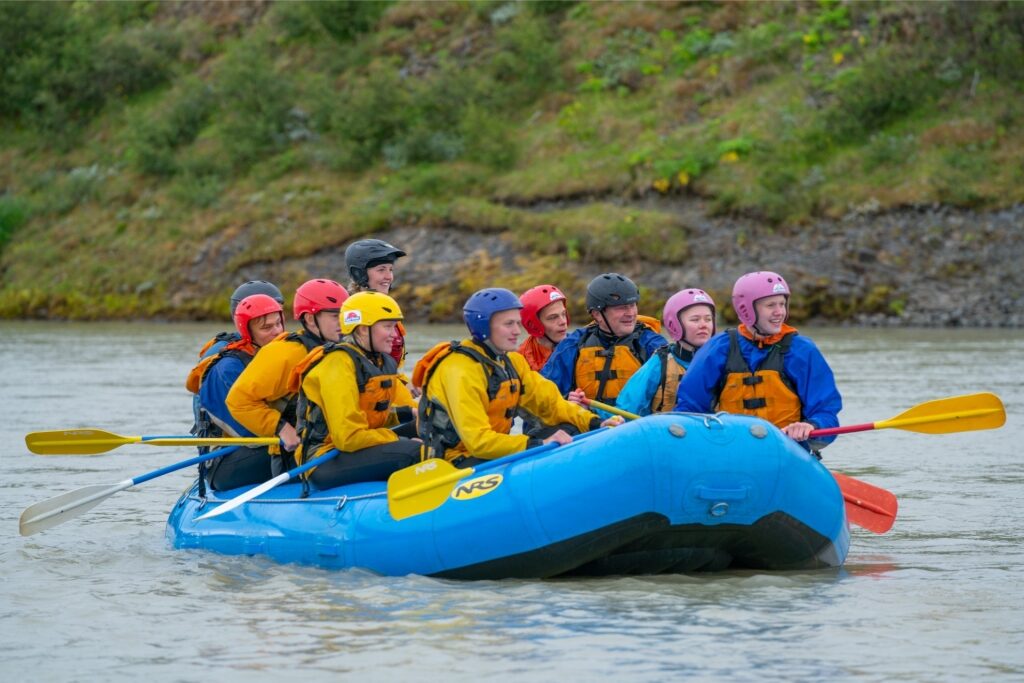
Hvita River
Adrenaline-seekers game for a white-water adventure can try rafting on the twists and turns of the Hvita river, which flows 25 miles from the enormous Langjokull glacier in Iceland’s highlands to Gullfoss waterfall.
Hvita widens to combine three rivers from the gorge at Gullfoss. Doubling in width, it’s perfect for white water rafting. Depart from Reykjavik on a short drive to the river where you will don a wetsuit, helmet, and life jacket and prepare to embark on one of the most thrilling things to do in Iceland.
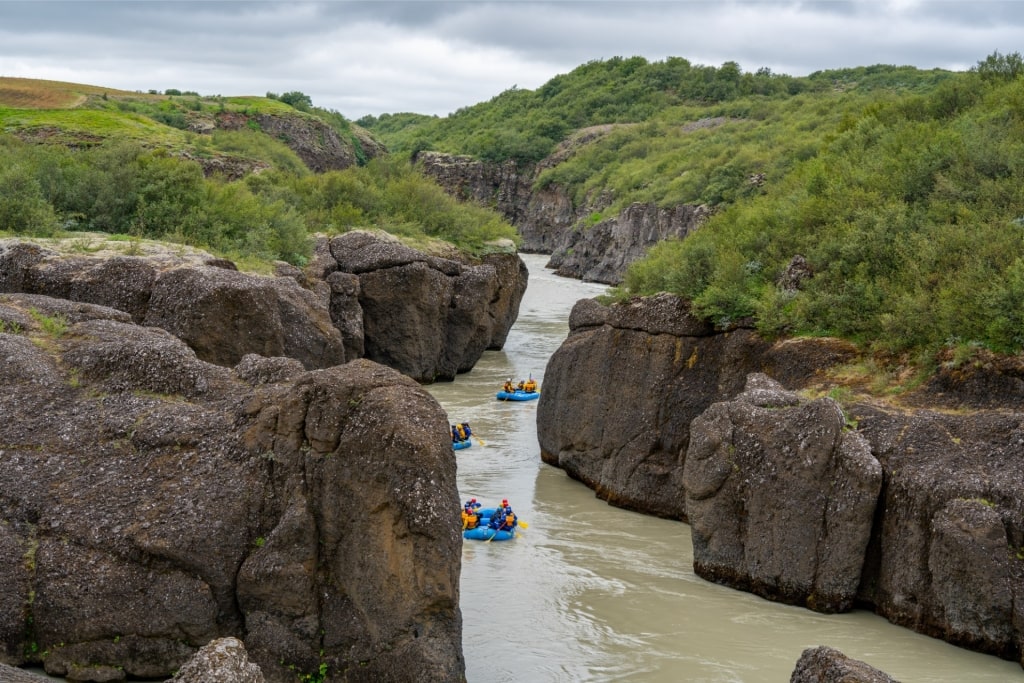
Hvita River
Prepare to navigate sharp turns in the valley and steer around rocky outcrops that punctuate the frothing water. It’s not all raging rapids and rushing water, with moments of calm and tranquility encountered when you can safely admire canyons covered in green moss while gently floating along.
White water rafting is suited to adults and older children, such as those older than 11. Pack a towel and a spare set of clothes to change into after your river adventure.
Read: What to Pack for Iceland
See a Puffin Colony on Vigur Island
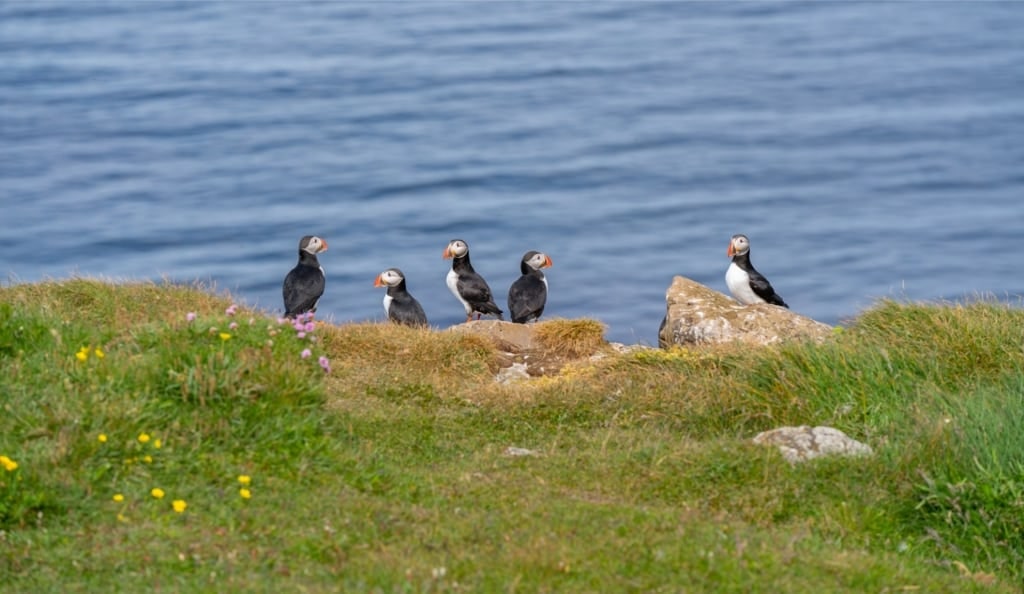
Puffins
A speck of an island situated in Ísafjarðardjúp fjord in the secluded Westfjords, Vigur is a green and fertile island that’s a mecca for seabirds—eider ducks, a rare colony of black guillemots, razorbills, and Arctic terns—during summertime.
There’s also a seal colony on the south of the island and whales are often spotted in the frigid waters surrounding Vigur, making a trip here one of the best things to do in Iceland for nature lovers.
A highlight is spotting some of the orange-billed Atlantic puffins, especially if you spot them clutching a beak filled with sprats (small silvery fish). There are an eye-popping 100,000 taking to Vigur Island annually between May and August, making it one of the largest puffin colonies in Iceland.
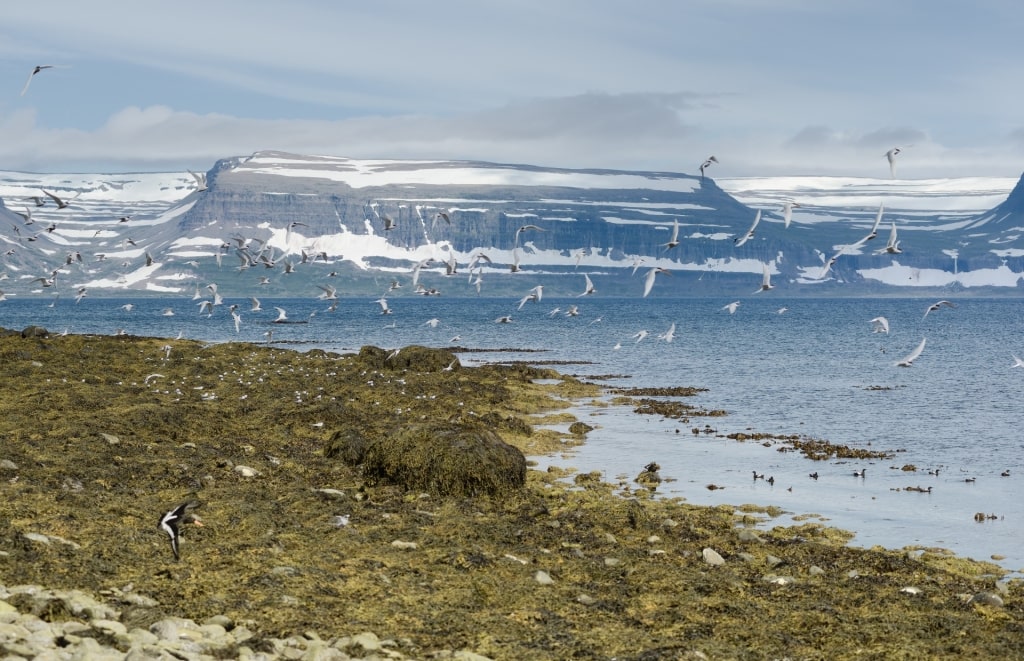
Vigur Island
Join a guided walk around the island to see an array of squawking seabirds and watch the annual eiderdown harvest and processing take place between May and August. The island’s only residents are a family of three and their occasional seasonal help who collect the silky-soft eiderdown left behind by the eider ducks. The island’s precious gray harvest is then exported around the world.
Vigur also has a tiny post office, considered the smallest in Europe, where you can mail a postcard back home, and a delightful café serving warm slices of Hjónabandssæla, a traditional Icelandic rhubarb pie topped with crumbly oatmeal.
Gaze at Reykjavik from Hallgrímskirkja’s Observation Deck
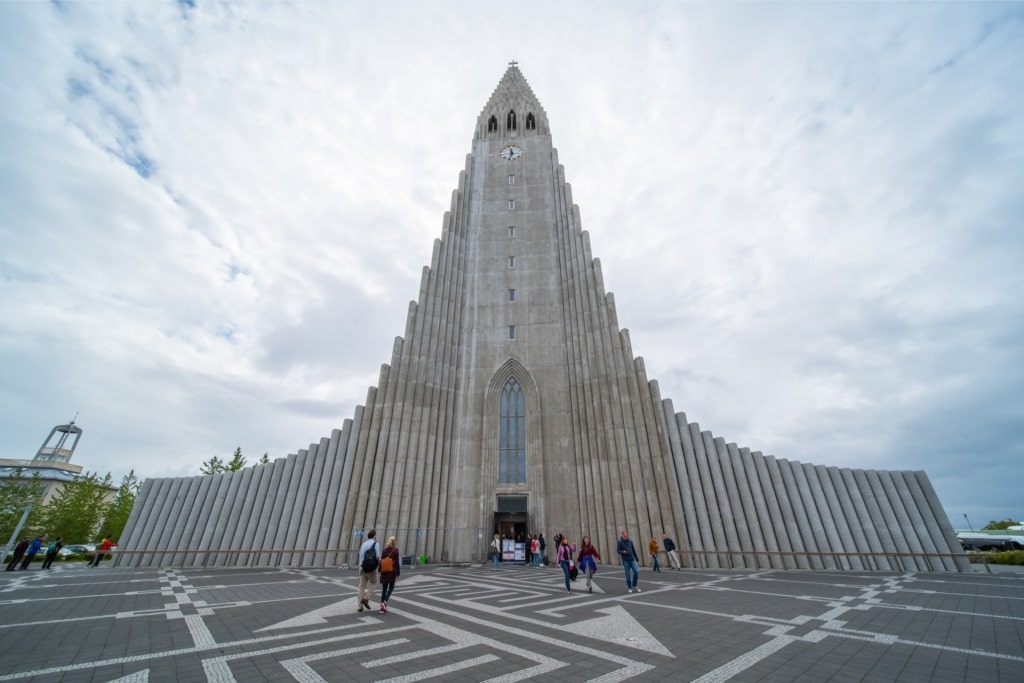
Hallgrímskirkja, Reykjavik
One of the most famous buildings in Iceland is Hallgrimskirkja, a modern church that soars above the city in downtown Reykjavík. At 244 feet, it’s one of the tallest buildings in Iceland, with its architecture mimicking the appearance of cooling lava as it chrysalises into pillars of igneous rock.
Completed in 1846 following a 40-year build, this unique building has become a symbol of Reykjavík’s modernity, with the striking design the work of architect Guðjón Samúelsson.
Admire this eye-catching church from the square outside where there is a statue of Leifur Eiríksson, a Norse explorer who is considered the first European to arrive on continental America.
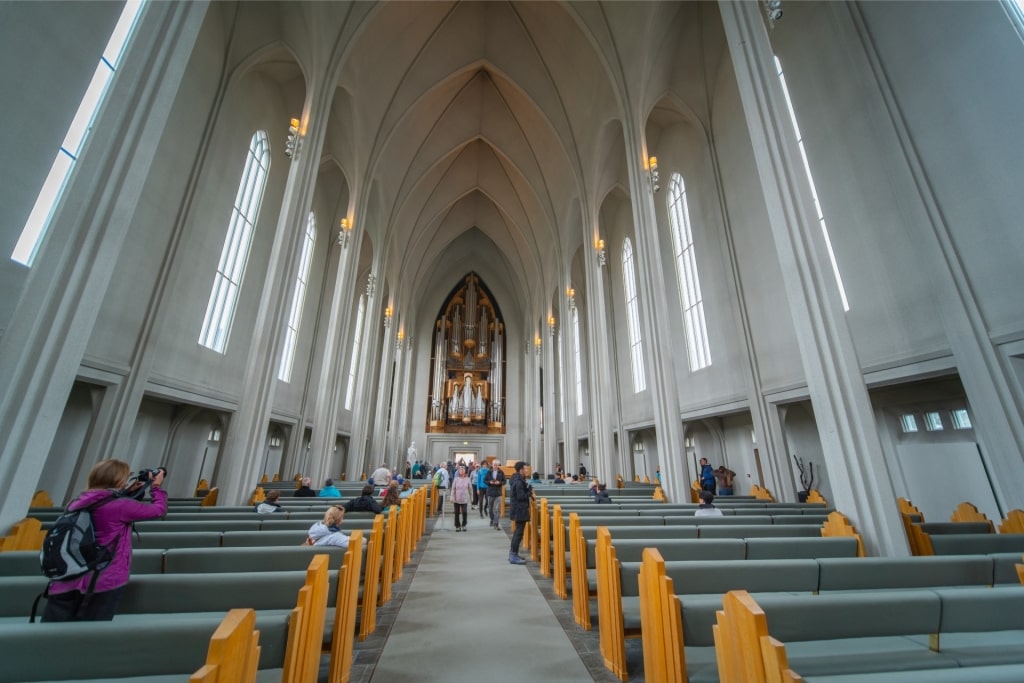
Hallgrímskirkja, Reykjavik
Step inside the church to see the 5,275-pipe organ that was installed in 1992 before taking the elevator to Hallgrimskirkja’s open-air observation deck. The views unfurl to the hazy horizon of Iceland’s mountains and ocean beyond the city.
Spot Cetaceans on the Edge of the Arctic Circle
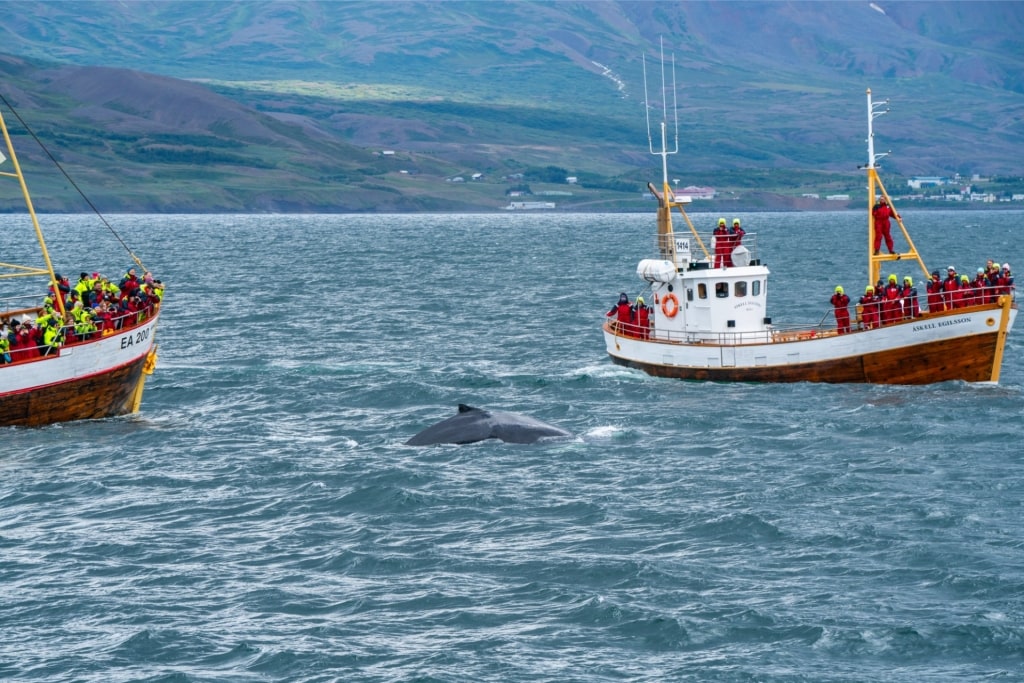
Whale watching in Akureyri
One of the best places in the world to go whale watching is in Iceland, in the lively waters of the North Atlantic Ocean. Here, majestic cetaceans, including sperm whales and harbor porpoises, are plentiful, particularly during summertime, when they’re drawn to the mix of cold and warm sea currents, and waters rich with fish.
Minke whales and white-beaked dolphins are most commonly spotted around Iceland, including on whale-watching trips from Reykjavik. Orcas, or killer whales, can also be seen throughout the year, swimming closer to shore during summer in Iceland.
For some of the best whale watching in Iceland, however, join a summer tour from Akureyri in the north. Have your camera ready for peeking dorsal fins of minke whales, tail slapping humpbacks, and orcas leaping clean out of the water, putting on a wonderful display.
Enjoy a Bird’s Eye View from a Helicopter
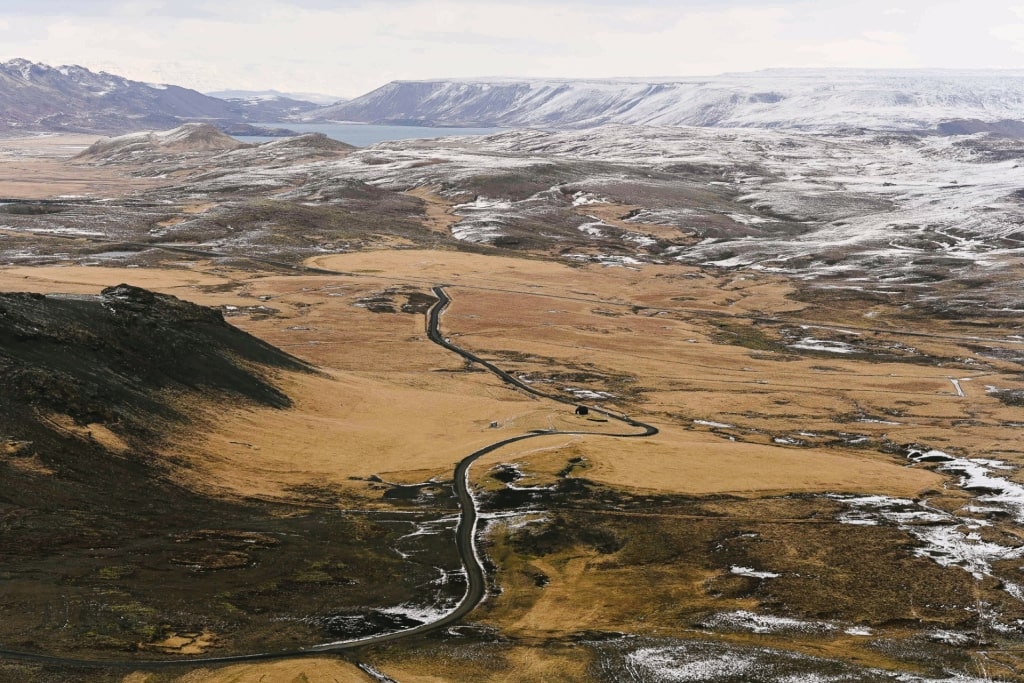
Reykjanes Peninsula
A helicopter tour is one of the failsafe things to do in Iceland to really capture the magnitude of the country’s colossal natural sights.
Bucket-list flights depart from Reykjavik Domestic Airport, just outside of the city center. Passengers are whisked high above the city’s traditional tin roofs for a bird’s-eye view of the pointed Hallgrimskirkja church, before reaching the volcanic landscape of the Reykjanes Peninsula.
See bubbling Icelandic hot springs and fumaroles before gazing at the extraordinary Sundhnukagigar craters and sites of the Litli-Hrutur and Fagradalsfjall eruptions near the town of Grindavik before returning to the capital with stirring memories of Iceland.
Explore Thingvellir National Park
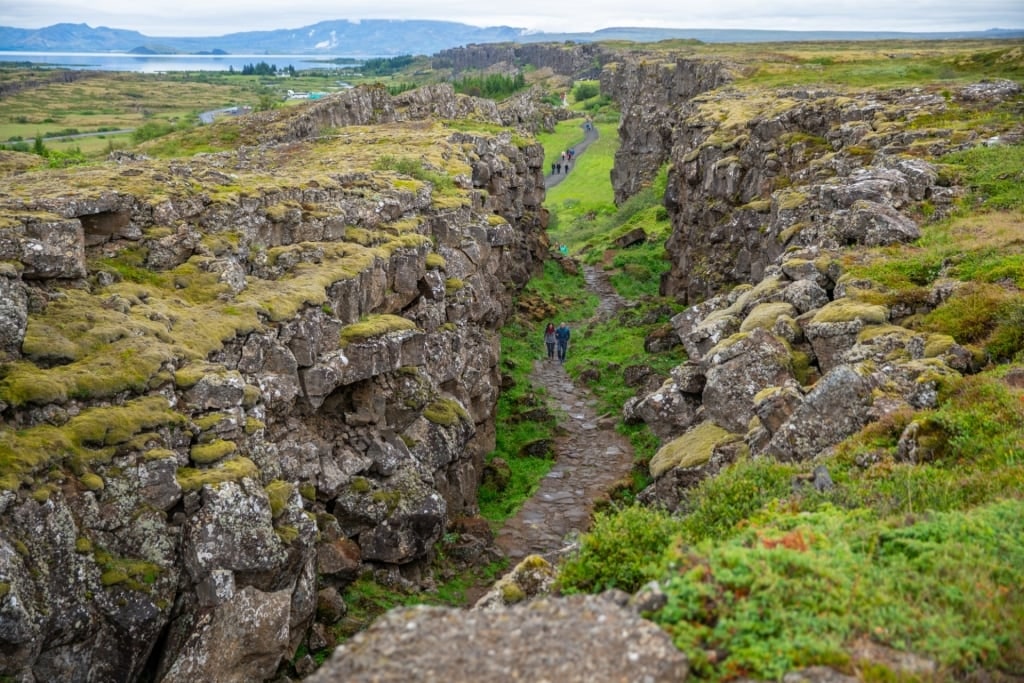
Thingvellir National Park
The UNESCO-listed Thingvellir, or Þingvellir in Icelandic, is not only an active volcanic area, but the site of the country’s first parliament. Iceland’s open-air assembly was established in 930 AD and remained here, by the river Öxará, roughly 27 miles east of Reykjavik, until 1798.
You could visit the site where lawmakers once met, with the remains of around 50 turf and stone-built booths, plus further 10th-century remains buried underground, within the park. Learn about the history of Iceland and this breathtaking national park at the visitor’s center near the pretty Þingvellir church.
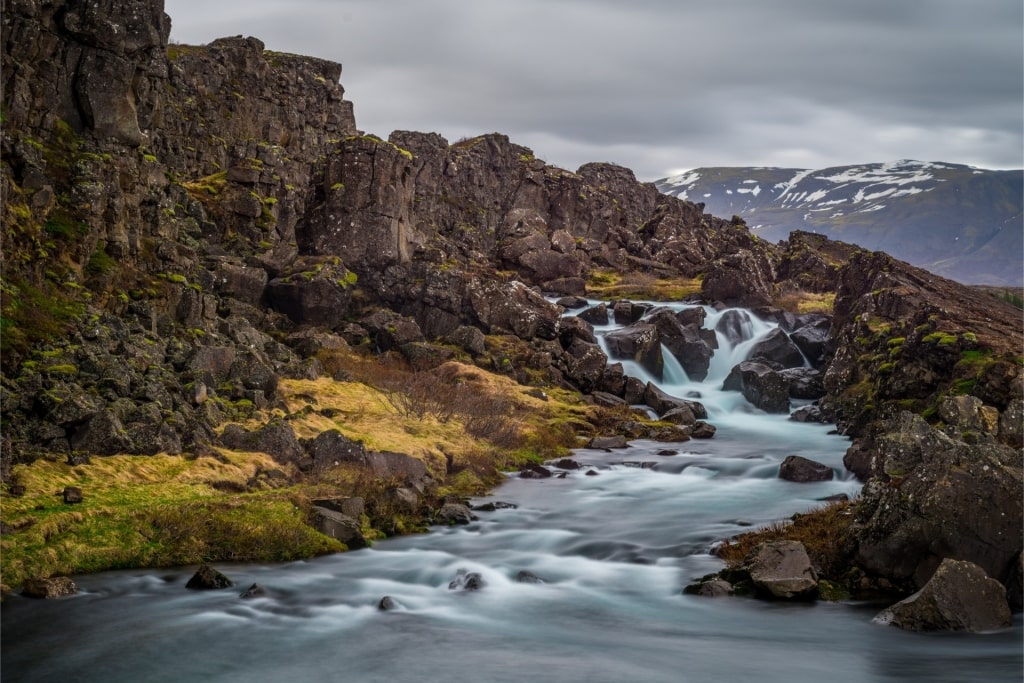
Thingvellir National Park
Perhaps what lured Iceland’s lawmakers over one millennia ago was the sensational scenery. Thingvellir lies on the Mid-Atlantic rift, where the North American and Eurasian tectonic plates meet. There are rugged mountains, rousing waterfalls, and the central Lake Þingvallavatn—the largest lake in Iceland—filled with brown trout and Arctic char.
Signposted hiking trails lead to a series of abandoned farms, including Hrauntún, Skógarkot, and Vatnskot. A popular walk is to Öxaráfoss waterfall via the Almannagjá gorge on the edge of the North American plate.
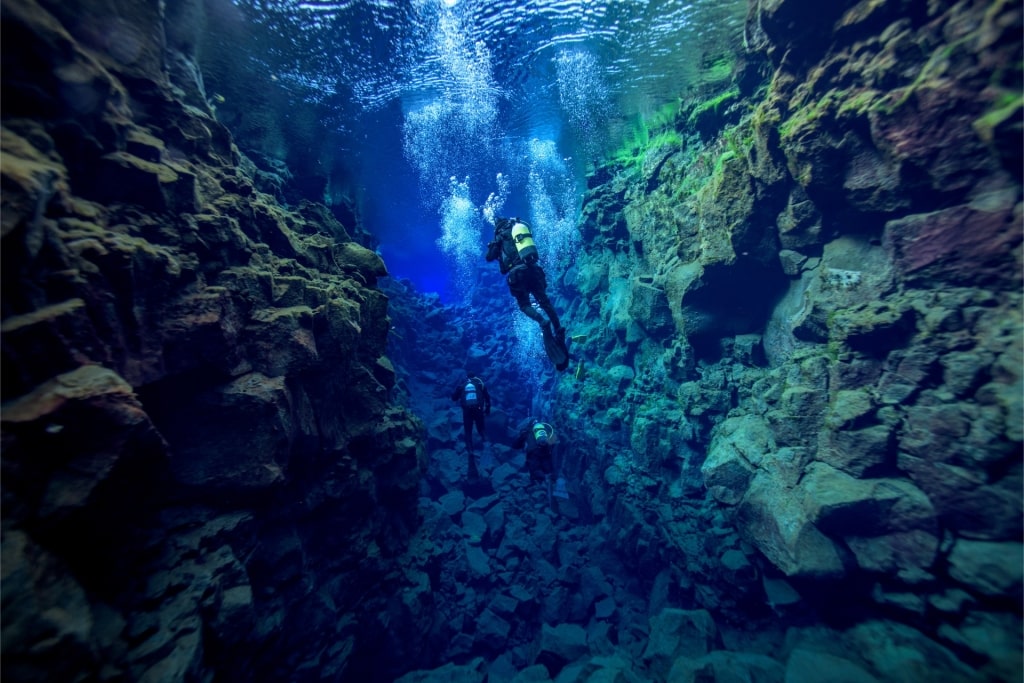
Silfra Fissure, Thingvellir National Park
Experienced divers could plunge into the lake’s sapphire-blue water at one of two underwater rifts, including Silfra, close to the park’s visitor center. The underwater visibility is extraordinary, making it one of the best diving spots in the world. However, travelers are required to hold a drysuit certificate or have done at least 10 registered drysuit dives in the last two years.
Divers are also required to obtain a permit from the park’s visitor center. It’s worth it, though, to see the meeting of the tectonic plates and spot the small, but resilient spined stickleback, a shimmering fish also found in the lake.
Visit a Deserted Village in the Westfjords
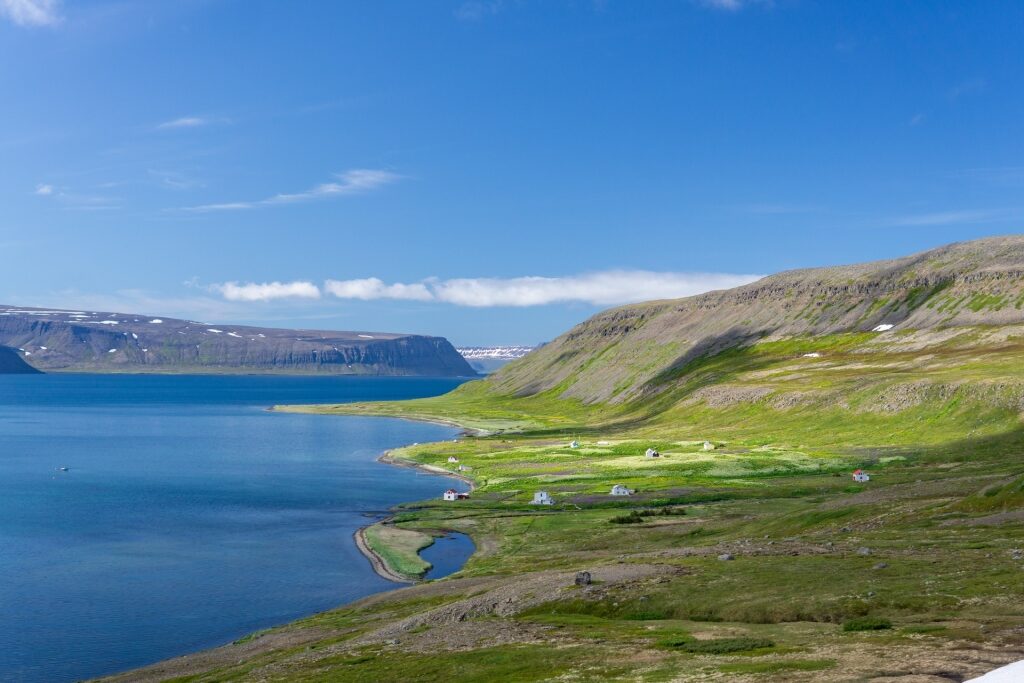
Hesteyri
Adventurous travelers will relish the chance to visit a deserted village, Hesteyri, on the edge of Hornstrandir Nature Reserve in the Westfjords.
Hesteyri lies in one of the most remote parts of Iceland, where an abundance of flora and fauna thrives, including Arctic foxes, seals, tundra, and wildflowers, while humpbacks can often be seen on the boat ride across the fjord from Ísafjörður.
Join a local guide to learn about Hesteyri’s history. Eighty people once lived in this fishing and whaling village on the Jökulfirdir fjord, though it has been abandoned since 1952. This haunting landscape is marked by an abandoned whaling station, dotted with swan-white huts.
Stop for coffee and cake at the small building known as the Old Doctor’s House. You could also enjoy an exhilarating walk by following the headland trail to spot nesting birds and seals.
Read: Best Things to Do in Isafjordur
Savor Icelandic Cuisine in Reykjavik
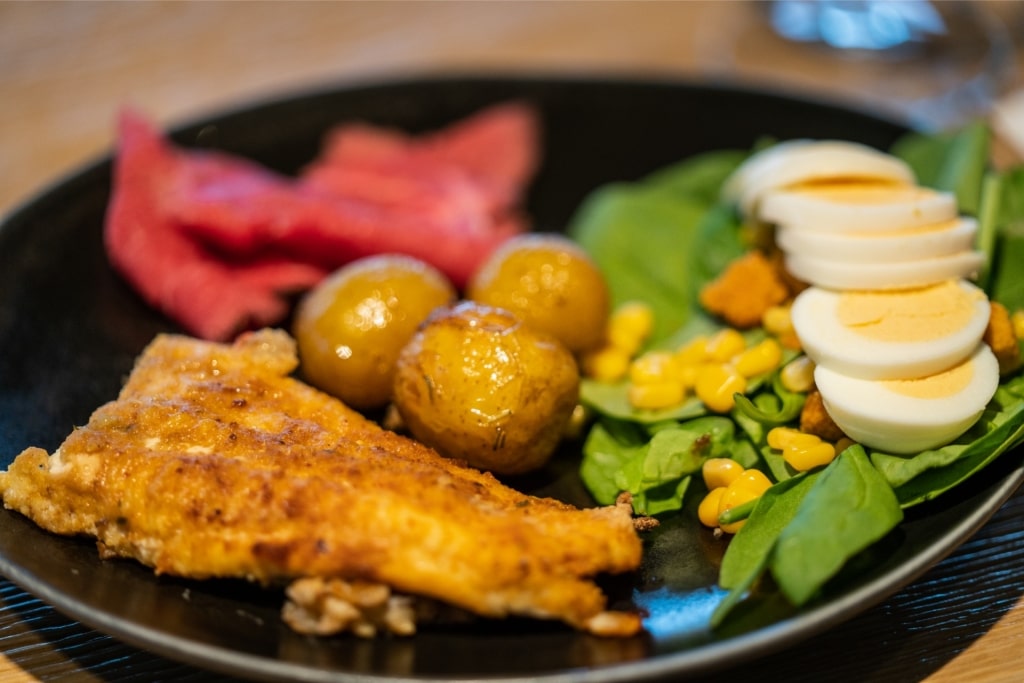
Icelandic food
Thanks to a bounty of top-notch produce—think ultra-fresh seafood, free-grazing lamb, mountain herbs, and local cheeses—combined with some excellent cooking, Iceland is a top destination for foodies.
Savor some of the best Icelandic cuisine on a walking tour with a local guide to try traditional Skyr (a dairy product similar to yogurt), grass-fed lamb, mouthwatering seafood soup, and homemade ice cream. Finish a tour at the city’s beloved hotdog stand, Bæjarins Beztu Pylsur, by the harbor. Order the works, complete with fried onions, mustard, remoulade, and tomato ketchup.
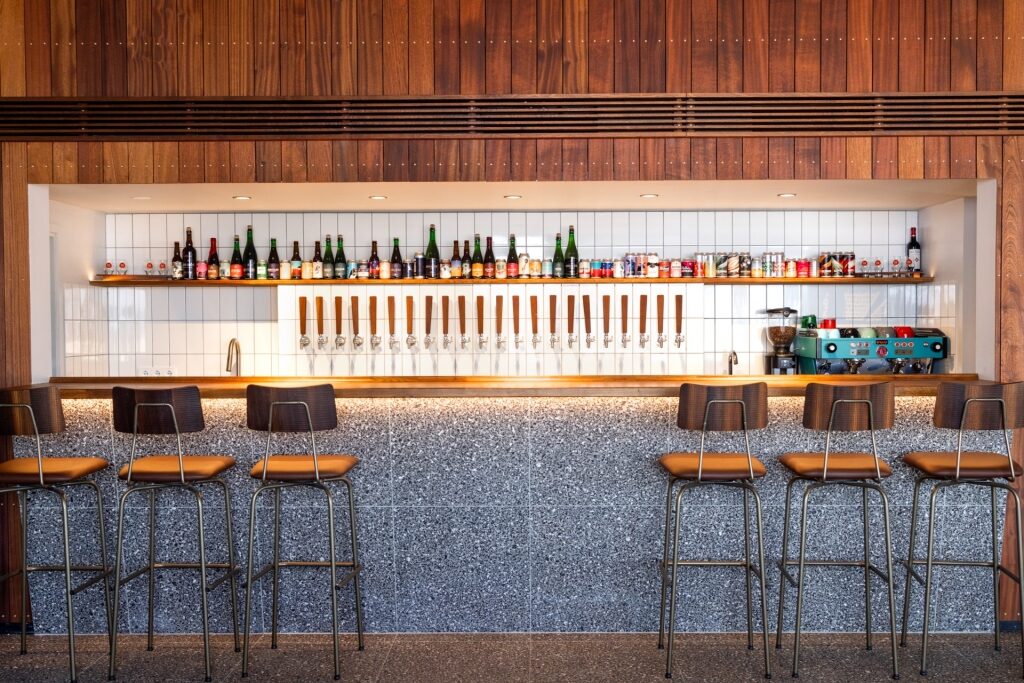
RVK Brewing Company, Reykjavik
You could also sip on local libations at one of the city’s many craft breweries, with a rising number popping up in the capital, including Skúli Craft Bar. Several taps are available, including Úlfur (Indian Pale Ale), Ríó (Pilsner), and Garún (Imperial Stout). There’s also RVK Brewing Company, where the refreshing Barfluga lager is a must try, and Bryggjan Brugghús for a brewery tour and tasting.
Foodie travelers who prefer to sit down over a sophisticated meal are in luck, too, with a slew of stellar restaurants in the city including Brut, Dill, and Óx, where patrons are treated to sublime Icelandic dishes in a stylish setting.
Step into the Arctic Circle on Grímsey Island
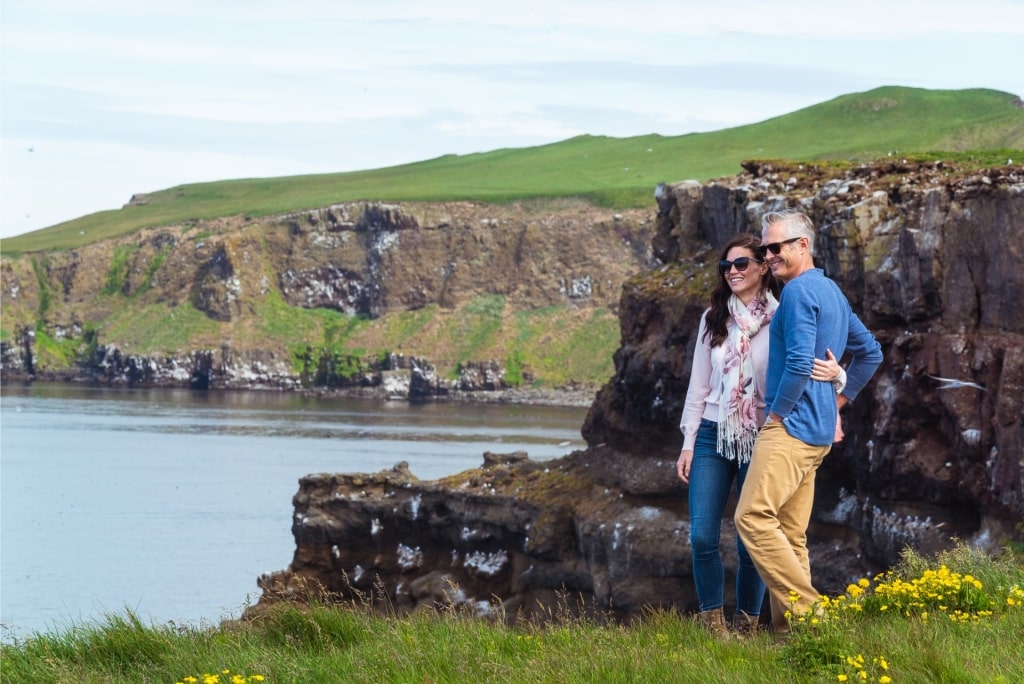
Grímsey Island
Windswept Grímsey is one of the best places to visit in Iceland. This far-flung island, 25 miles off Iceland’s north coast, is home to just 100 people and roughly one million seabirds that are drawn here because of the fish-filled waters.
The island, lying directly on the Arctic Circle, features high sea cliffs and is typically blanketed in snow during winter and carpeted in luxuriant green during summer. The kaleidoscope of bird life includes Atlantic puffins between April and August, razorbill, black-legged kittiwake, black guillemot, northern fulmar, and thick-billed murre. Grímsey is also one of Iceland’s largest tern nesting sites, so be careful if you venture into these; the tiny and fearless Arctic terns will dive-bomb intruders to drive them away.
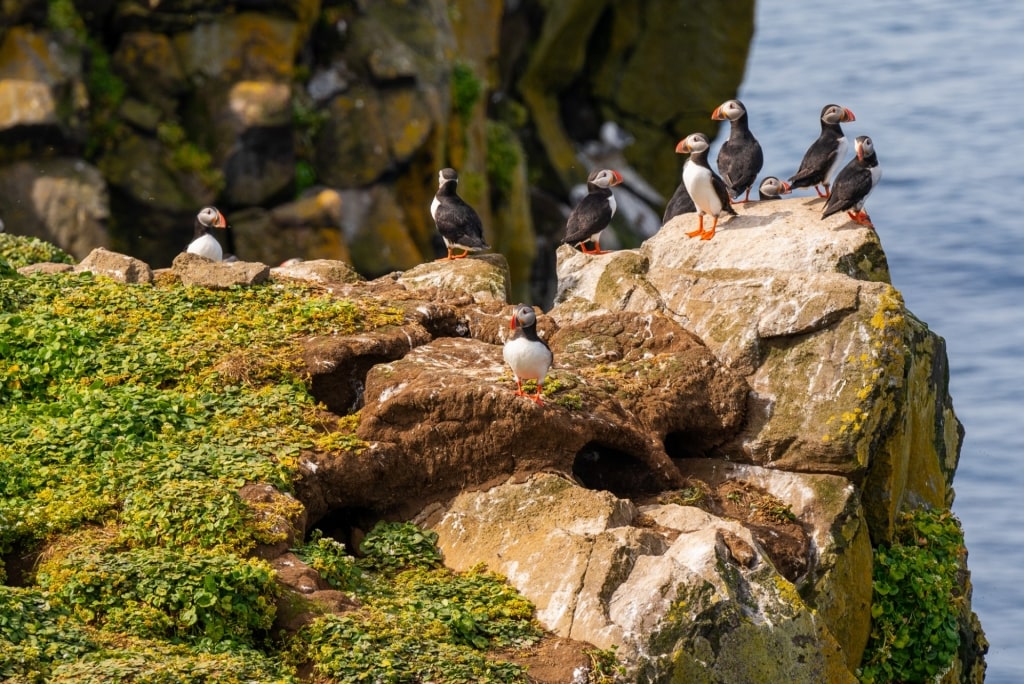
Puffins
The island’s small village, Sandvík, is reachable by boat from the mainland, and features a wooden church, one restaurant, and a scattering of houses facing the harbor.
There’s also a charming green road train operating (June to August) the length of the island, from the orange lighthouse on the southern tip, through the village, toward the concrete orb-like Arctic Circle monument on the north side. The hop-on, hop-off road-train is a great way to spot some of Grímsey’s bird life.
If you’re a cold water swimmer, Grímsey is the perfect place to do it during summer. The water will be cold, but it’s deliciously clear. The best place to go for a refreshing dip is close to the harbor, on the west coast. Consider thermal swimwear and a robe to wrap up in when you emerge from the Arctic water.
Wander Among Dimmuborgir Lava Field
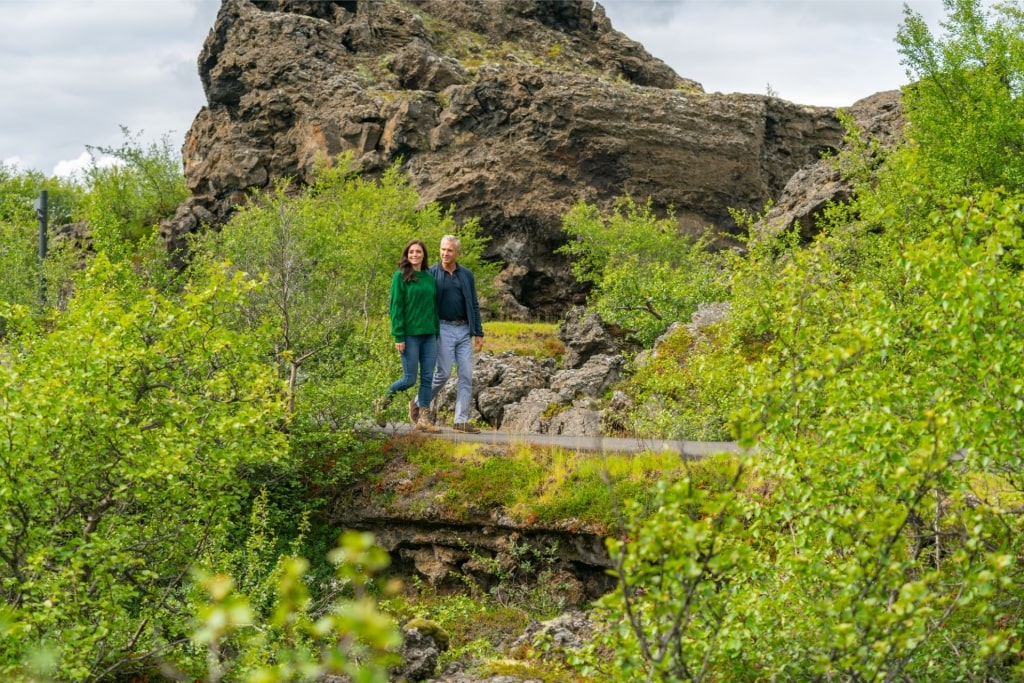
Dimmuborgir Lava Field
Dimmuborgir, which roughly translates as dark city, is a mystical and craggy landscape of lava fields, steeped in folklore to the east of Lake Mývatn in northern Iceland.
This sculptural landscape was created 2,300 years ago, the result of lava flowing from a massive eruption into a lake, which caused the lake’s water to boil. The rising steam led to some of the hardening lava to shatter, resulting in Dimmuborgir’s towering black stacks and imposing rock formations.
Walking among Dimmuborgir is one of the best things to do in Iceland, not just for geology buffs, but keen photographers, and fans of popular culture (the location has been used as a backdrop in a famous fantasy TV show), too.
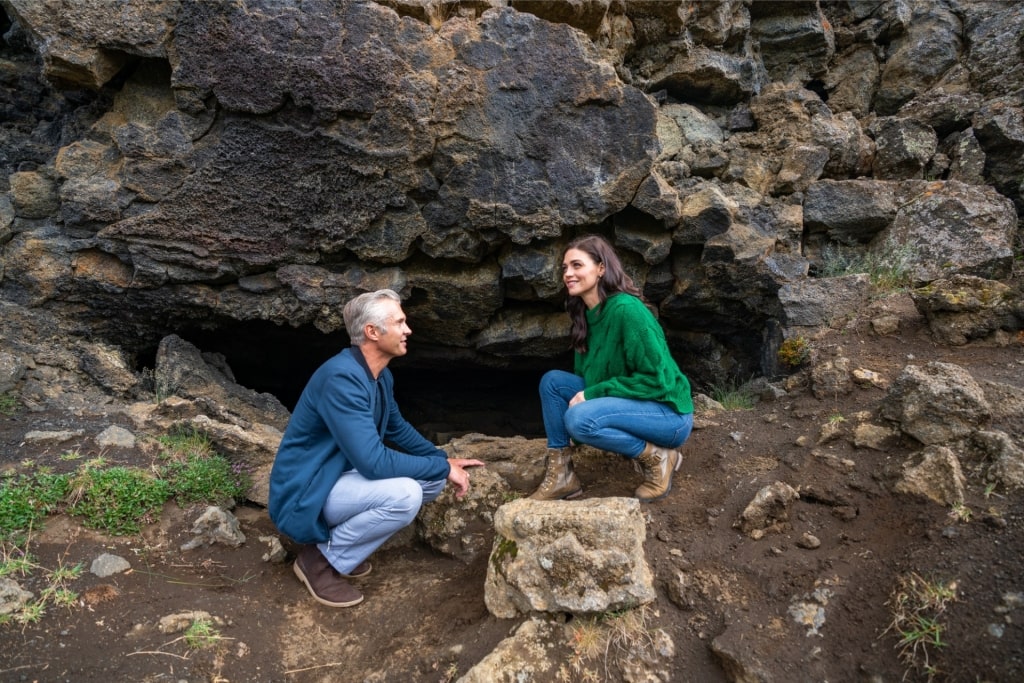
Dimmuborgir Lava Field
Learn about tales of trolls who allegedly lived in Dimmuborgir’s lava caves, including the Yule Lads, Iceland’s folkloric, mountain-dwelling Father Christmases (there are 13), as you follow one of the dedicated paths around the lava fields.
Tour Glaumbær Farm Museum
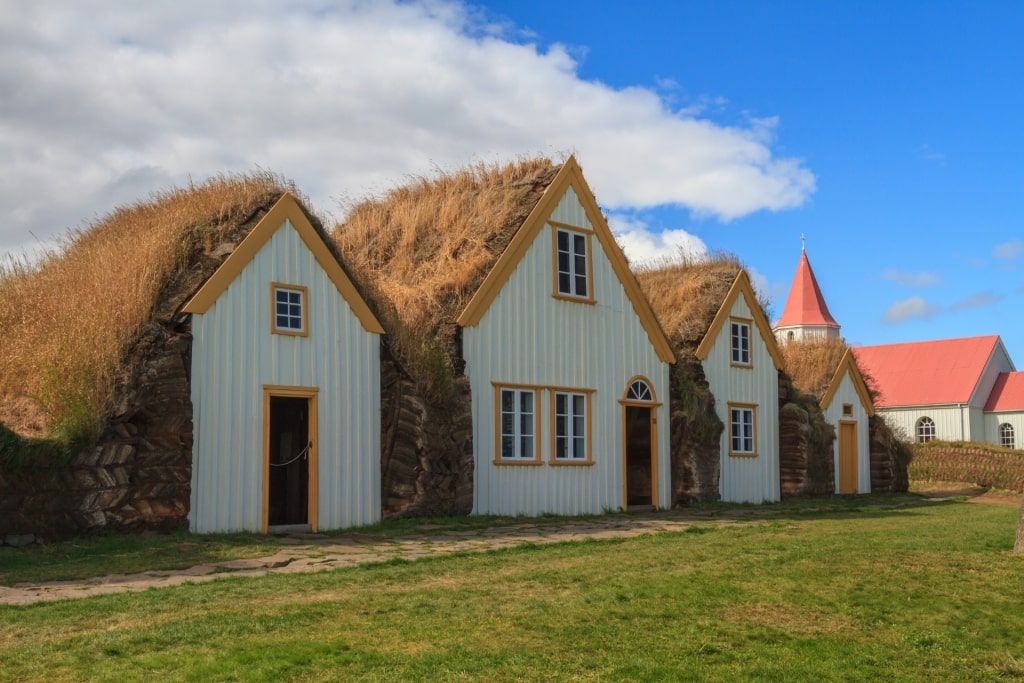
Glaumbær Farm Museum
A visit to Glaumbær Farm, owned by the National Museum of Iceland, near Akureyri is one of the most fascinating things to do in Iceland.
Glaumbær Farm is made up of 13 traditional turf houses constructed in the 1800s on the site of a settlement that can be traced back to 874. These white-painted houses are a piece of Iceland’s history, with the homes occupied until as recently as 1947.
Roam Glaumbær Farm to learn more about Iceland’s history of grass-roofed houses and take a peek inside to picture what home life was like here 200 years ago. While the turf houses appear like separate buildings from the outside, inside, they’re all connected and feature a communal living space called a baðstofa—a cozy space where families would gather to socialize, play games, knit, and tell stories.
Walk Among the Bubbling Haukadalur Valley
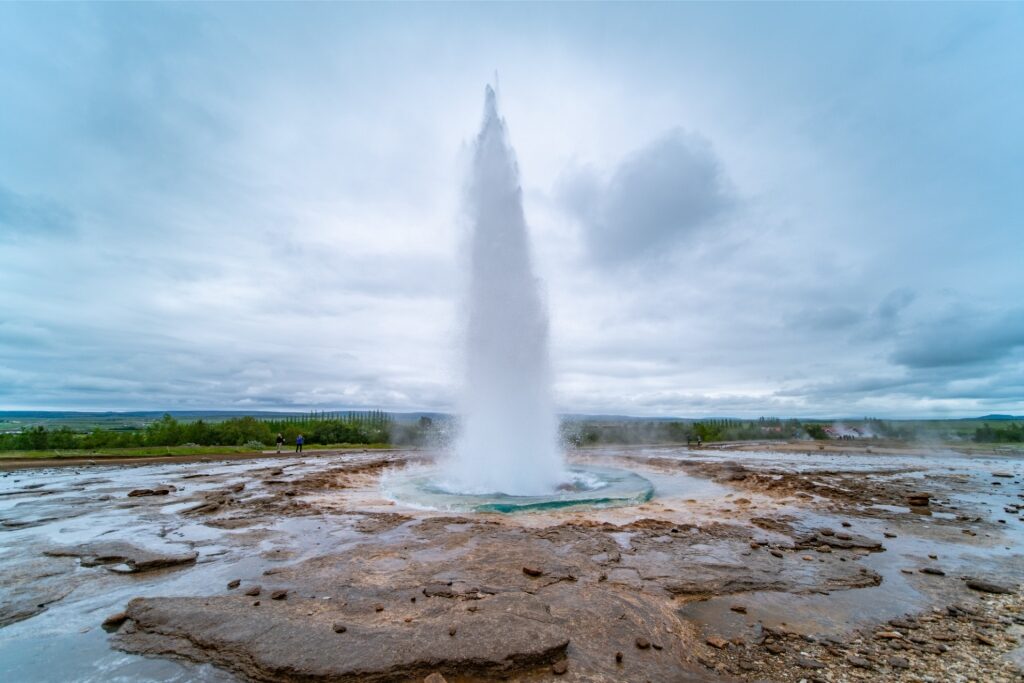
Strokkur Geyser
One of the most famous sights in Iceland is the gushing Strokkur Geyser in the Haukadalur valley, 66 miles east of Reykjavik. Visiting this magical spot is easily one of the best things to do in Iceland, with plumes of pressurized hot water shooting into the air, heated by bubbling magma below the earth’s surface.
Strokkur puts on a fabulous display, erupting through the porous rock roughly every five to 10 minutes. First, the surface around Strokkur heats to around 250°F before the steaming water erupts.
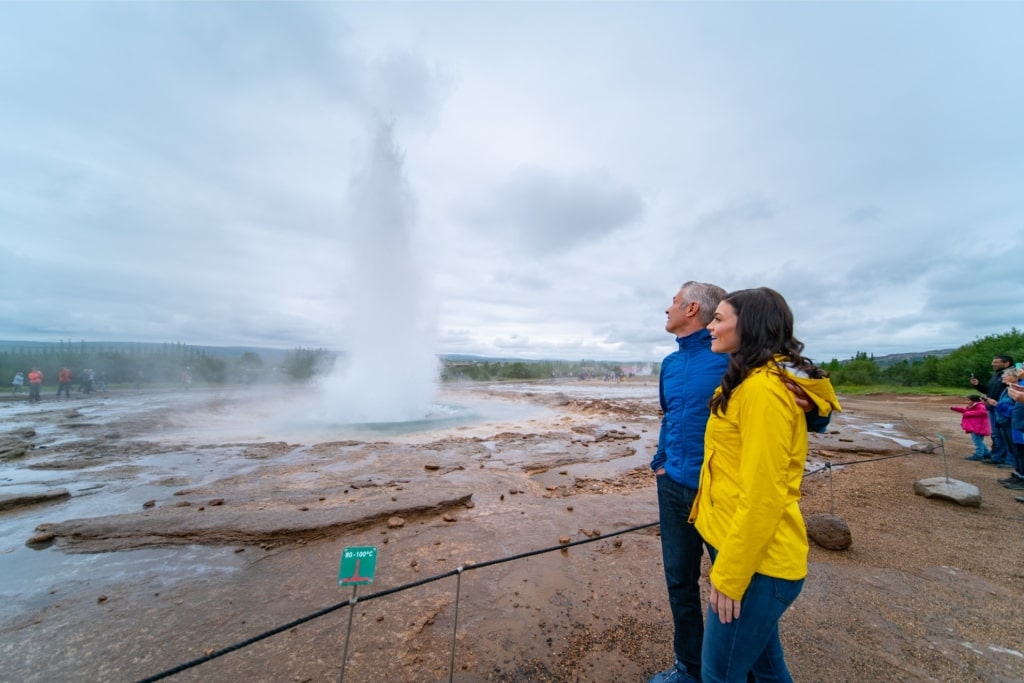
Strokkur Geyser
Wander among the designated areas within Haukadalur, with smaller geysers, fumaroles, hot springs, and mud-pits also bubbling away in this geothermal valley. Notice the color of the earth in places shimmers from yellow to green, and then red, displaying the sulfur, copper, and iron elements.
There’s an inviting café and restaurant for refreshments, and a lovely gift shop for picking up souvenirs to take home.
Shop for Souvenirs in Downtown Reykjavik
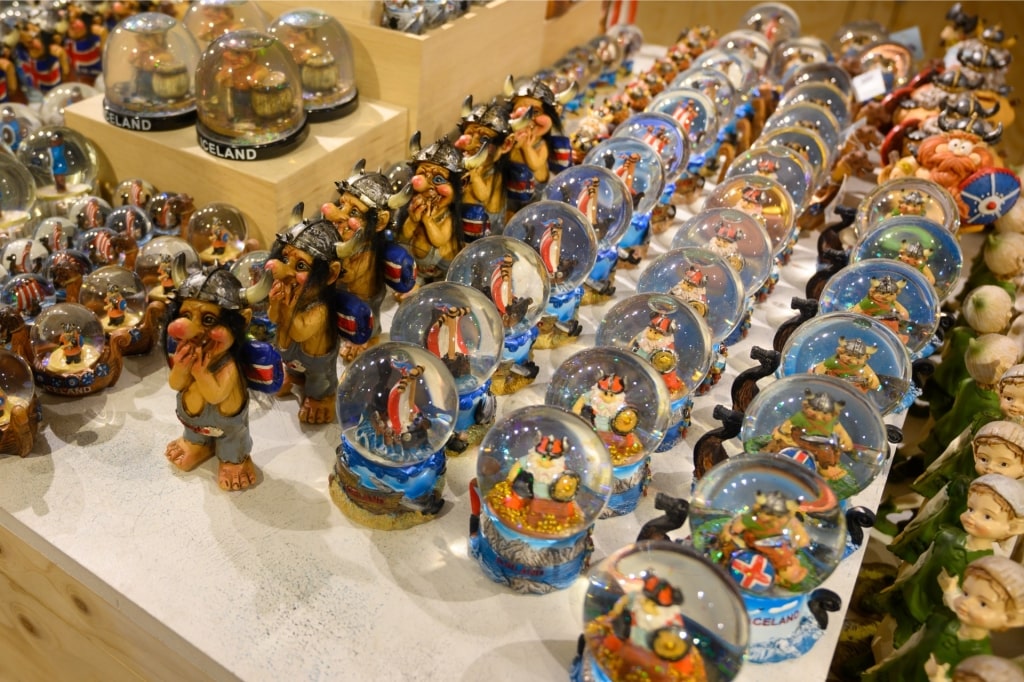
Souvenirs in Iceland
Not all things to do in Iceland involve exploring the country’s jaw-dropping landscape, as incredible as it is. Downtown Reykjavik, festooned with street art and concept stores, is a wonderful place to indulge in retail therapy.
This walkable city center is a treasure trove of arts and crafts, vintage fashion, and independent retailers of homeware and gourmet goods.
Focus a shopping trip on Skólavörðustígur, a one-mile pedestrian strip jam-packed with restaurants, bars, and shops, neighboring Laugavegur, and the interconnecting lanes.
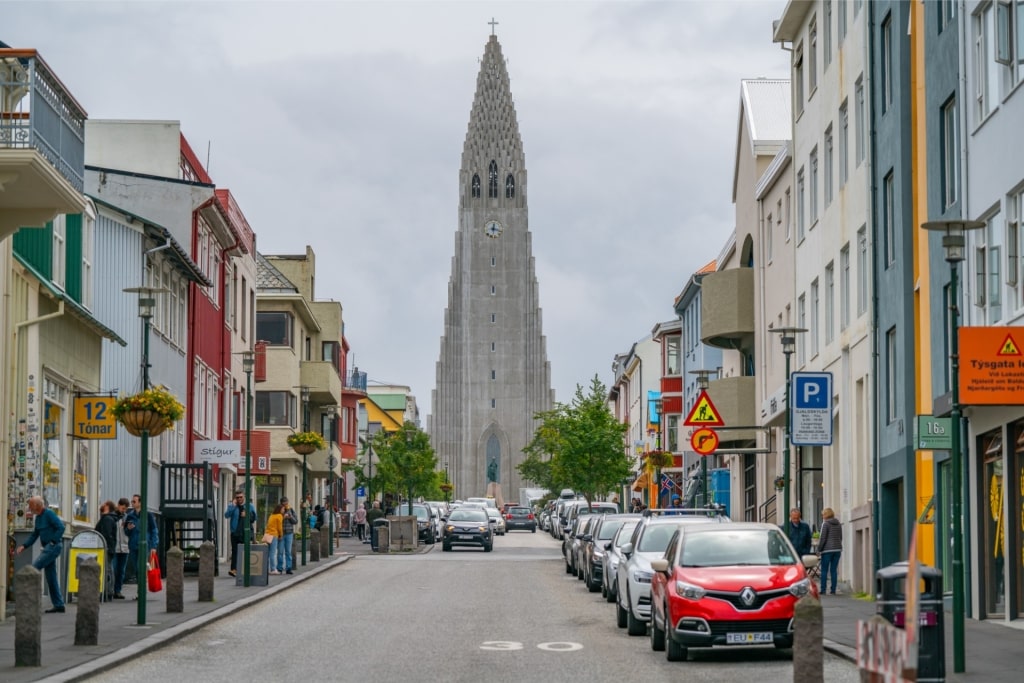
Skólavörðustígur, Reykjavik
On Skólavörðustígur, Fotografi is the spot to pick up beautiful photography of Iceland. Orrifinn sells one-of-a-kind jewelry, and Inga Elín offers gorgeous hand-crafted ceramics.
Browse the Blue Lagoon’s outpost on Laugavegur, selling the geothermal spa’s luxury hair, body, and skincare products, and stop by As We Grow for silky-soft knitwear for men, women, and children. Spúútnik, also on Laugavegur, is a mecca for jaunty vintage pieces, and there’s Aftur for highbrow sustainable fashion, accessories, and perfumes,
There’s more, including art shops, active-wear stores, bookshops, and places to pick up Viking-themed souvenirs in this wonderfully vibrant district of the city.
Read: Best Things to Do in Reykjavik
Discover Majestic Lake Mývatn
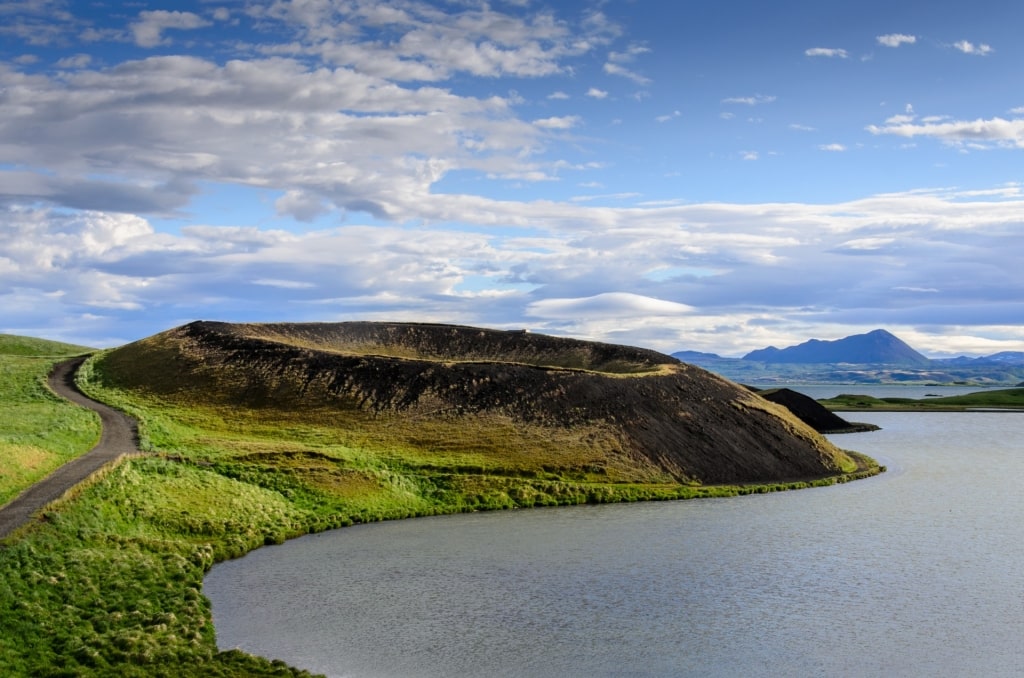
Lake Mývatn
Mývatn is one of the most beautiful lakes in the world. Located in northern Iceland, it is surrounded by lava fields, pseudocraters, and lava pillars that were created following a basaltic lava eruption that occurred close by around 2,300 years ago.
The 14-square-mile lake is home to an array of dazzling wildlife, including fish and many migratory ducks that arrive from springtime and stay for the summer, including tufted duck, harlequin duck, Arctic tern, and mallard.
Sigurgeir’s Bird Museum, on the north side of the lake, is a great place to learn more about the bird life and geology of Lake Mývatn. The museum is known for its impressive bird specimens, including almost every type of Icelandic breeding bird on display.
There are hiking routes and viewing areas around the lake, plus plenty of points of interest, including Stóragjá, on the northeast corner of the lake, home to a series of ancient caverns containing unique rock formations, geothermally-heated pools, and hot springs.
Take a Road Trip to the Snaefellsnes Peninsula
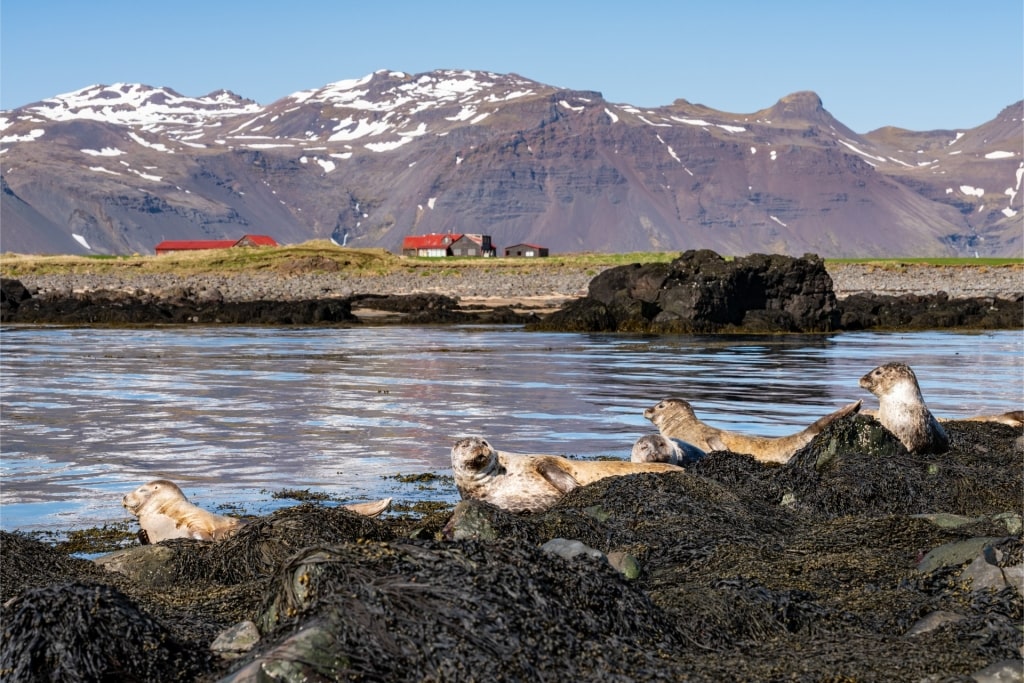
Ytri Tunga Beach
Iceland’s Snaefellsnes peninsula makes for a breezy road trip, lying across Faxafloi bay from Reykjavik, a picturesque two-hour drive from the capital city.
This western arm of Iceland juts out into the Atlantic Ocean and is home to the magnificent scenery of Snaefellsjokull National Park. There is a glacier-capped volcano and rousing mountains, plus tiny villages and glorious beaches strung around the coastline.
Relax at the golden Ytri Tunga Beach as you look for lazing harbor and gray seals found lying on kelp-covered rocks. Continuing along the peninsula’s south shore, stop at Búðir. Surrounded by lava fields, here there is a solitary church behind another blond beach that makes for a superb photo opportunity.
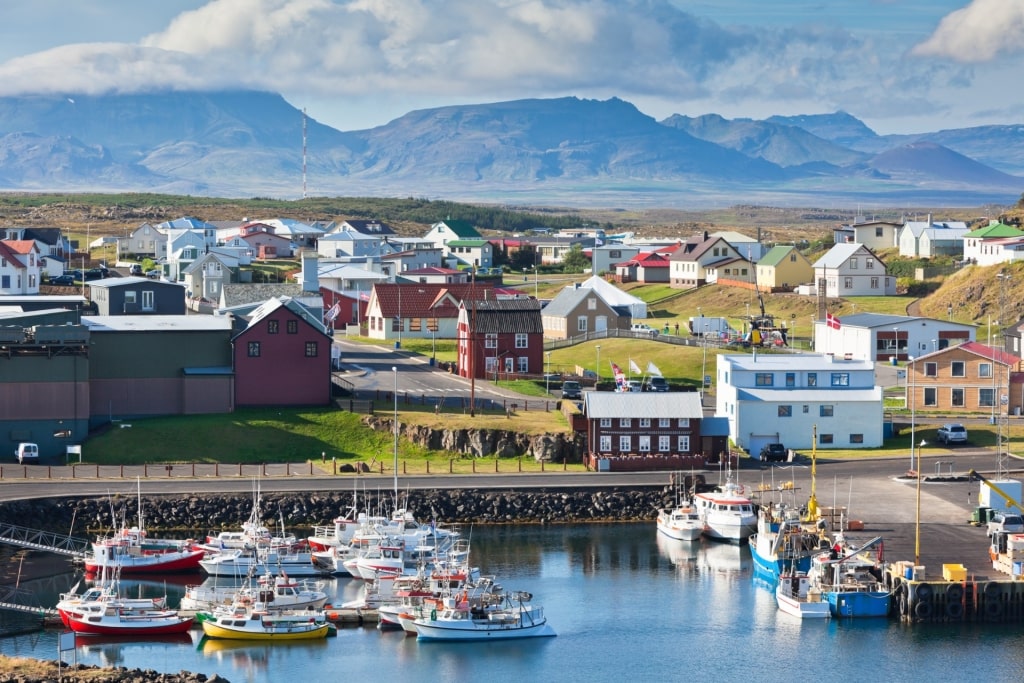
Stykkisholmur
The 700,000-year-old Snæfellsjökull glacier looms in the distance, behind the village of Arnarstapi, while the largest town on the peninsula is Stykkisholmur, on the north shore. Facing the Westfjords, Stykkisholmur is roughly a two-and-a-half hour drive from Reykjavik, and as with anywhere in Iceland, getting there is half the fun.
The town is also close to the Bjarnarhöfn Shark Museum, a fascinating stop on a tour of Iceland, revealing why shark meat is traditionally fermented for six months before being consumed. If you have a strong stomach, you can even try this Icelandic delicacy on a visit but be warned that it’s an acquired taste; most Icelandic people today wouldn’t touch it.
Hike Ásbyrgi Canyon
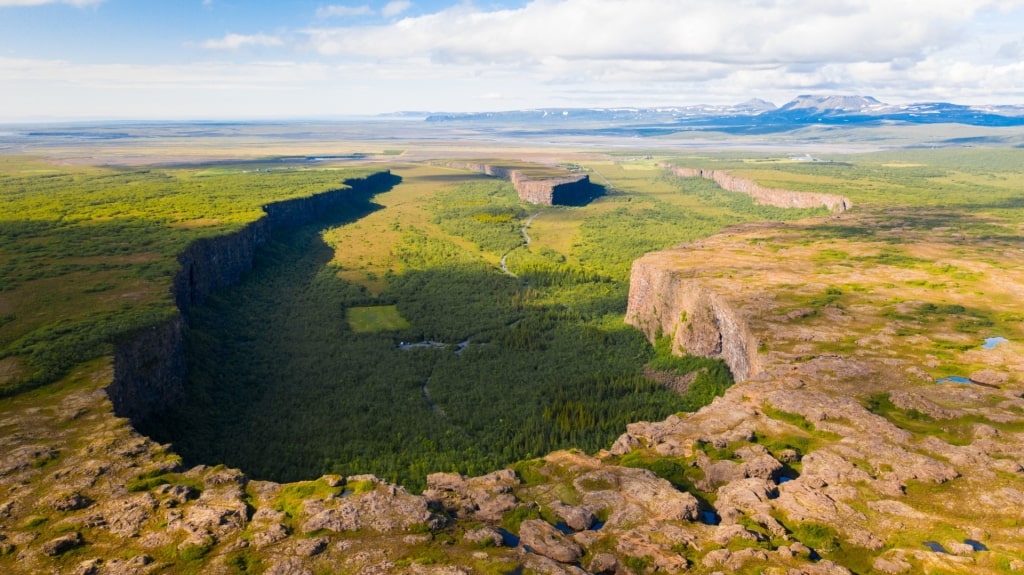
Ásbyrgi Canyon
Iceland is home to many head-turning landscapes, including the horseshoe-shaped Asbyrgi canyon, with cliffs that rise up to 330 feet in parts, within Vatnajökull National Park in the country’s far north.
If you believe in Norse folklore, this deep groove covered in lush vegetation was formed by the hoof of Odin’s eight-legged horse (Odin was the bearded God of War and Death and the God of Poetry and Wisdom in Norse mythology). The more scientific explanation is that Asbyrgi formed as the result of two catastrophic floods from the Vatnajökull glacier, some 3,000 and 10,000 years ago.
Getting to Ásbyrgi Canyon involves an intrepid coastal journey from Akureyri, taking around two hours. When you arrive, hike to the 82-foot Eyjan, a hulking rock formation that rises from the center of the canyon, surrounded by low-lying forest. The trail runs for a couple of miles and is popular with hikers for the breathtaking views of the canyon’s lush landscape.
Embark on a Tour of Reykjavik Museums
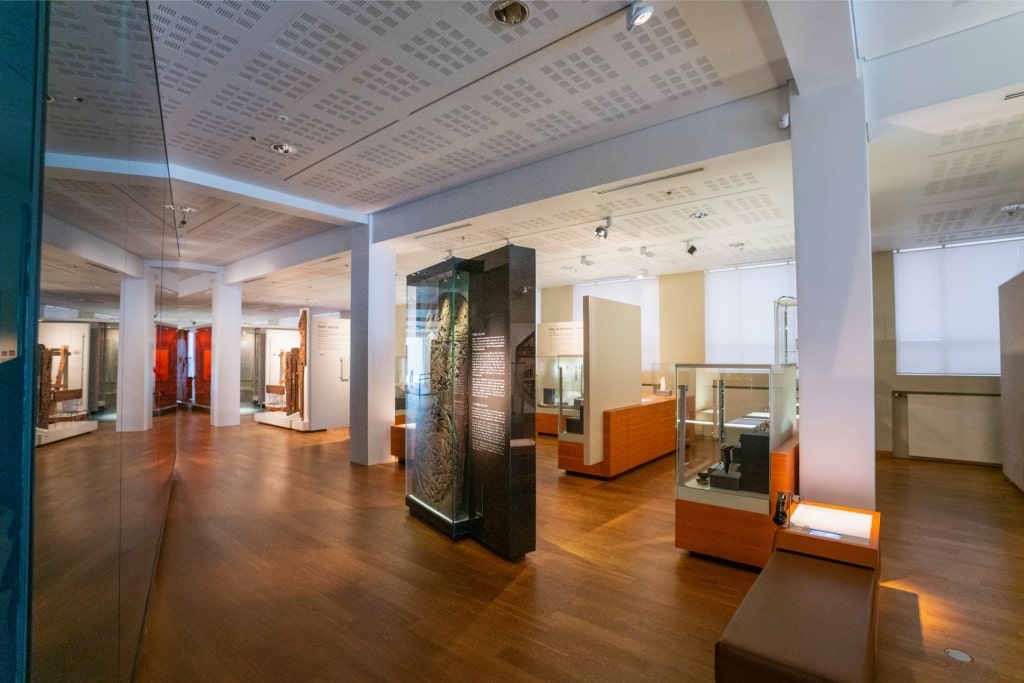
National Museum of Iceland, Reykjavik
For culture-thirsty travelers, spending a day touring Reykjavík’s top museums is one of the best things to do in Iceland.
Start at the National Museum of Iceland, which covers 1,200 years of the country’s cultural landscape, including everything from Viking history to paganism and whaling, displayed over three floors.
The family-friendly Whales of Iceland is a natural history museum dedicated to cetaceans, with 23 whale species on display. There’s also the Maritime Museum in a former fish freezing plant by the harbor for enthralling tales of Iceland’s seafaring heritage, and the Saga Museum where you could try on Viking costumes.
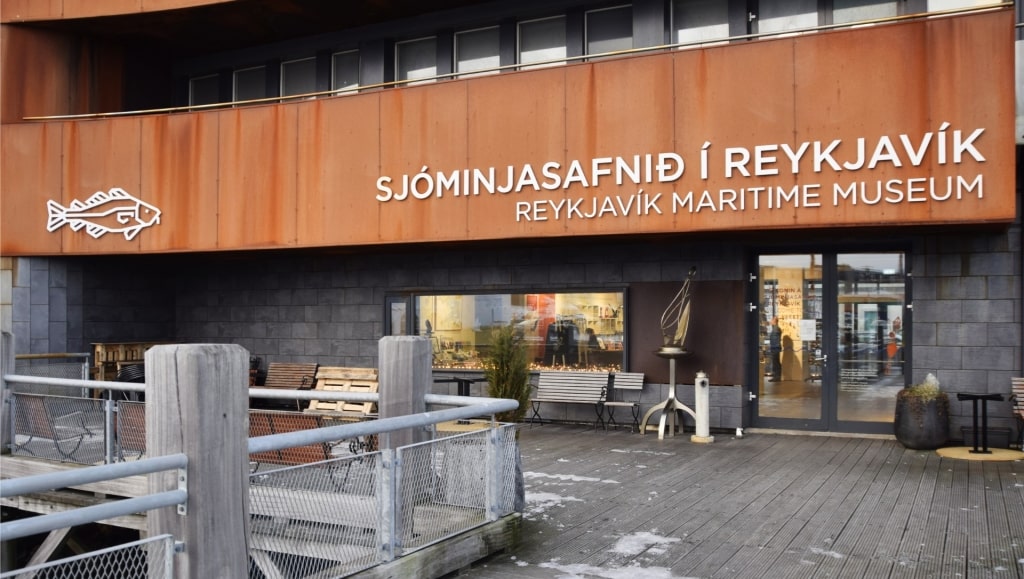
Maritime Museum, Reykjavik Photo by Mosbatho on Wikimedia Commons, licensed under CC BY 4.0
Experience the arresting Northern Lights year-round at Aurora Reykjavik, a museum dedicated to the aurora borealis. Learn all about the natural phenomenon, including the science behind why these luminous green and purple lights appear.
There’s an interactive exhibition, a 23-foot-wide movie theater showing the Northern Lights, a photography display, and a fun photo booth where you can capture a photo of yourself in front of one of the greatest shows on earth.
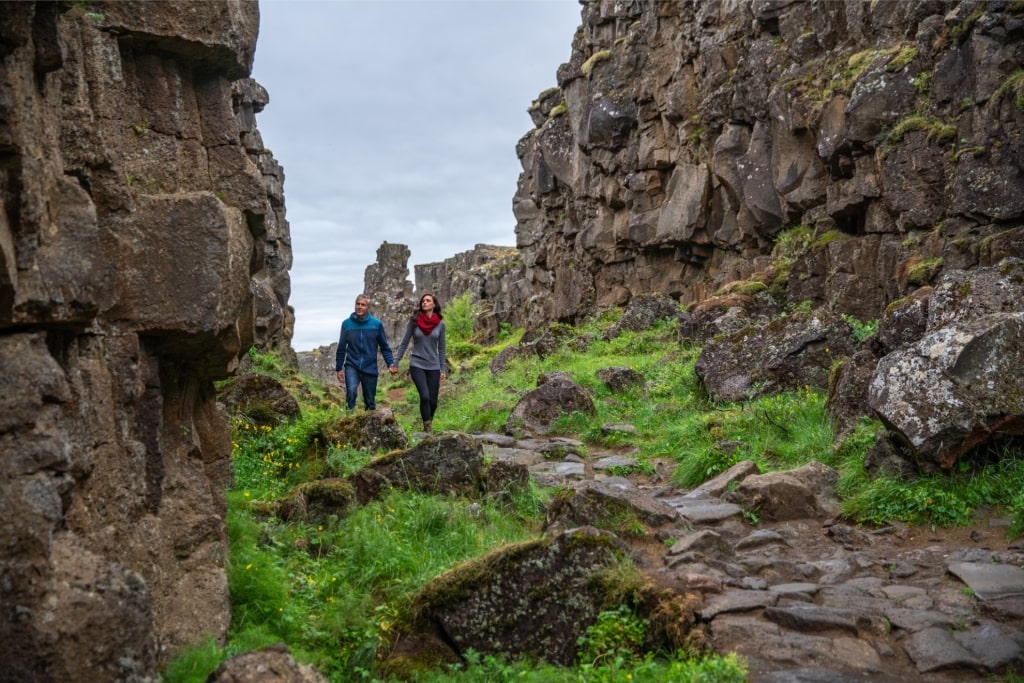
Thingvellir National Park
With glaciers, waterfalls, mountains, and volcanoes, not to mention a vibrant capital city, a vacation to Iceland is a soul-stirring experience. Explore Celebrity Cruises’ thrilling Iceland cruises to book your next intrepid getaway.
